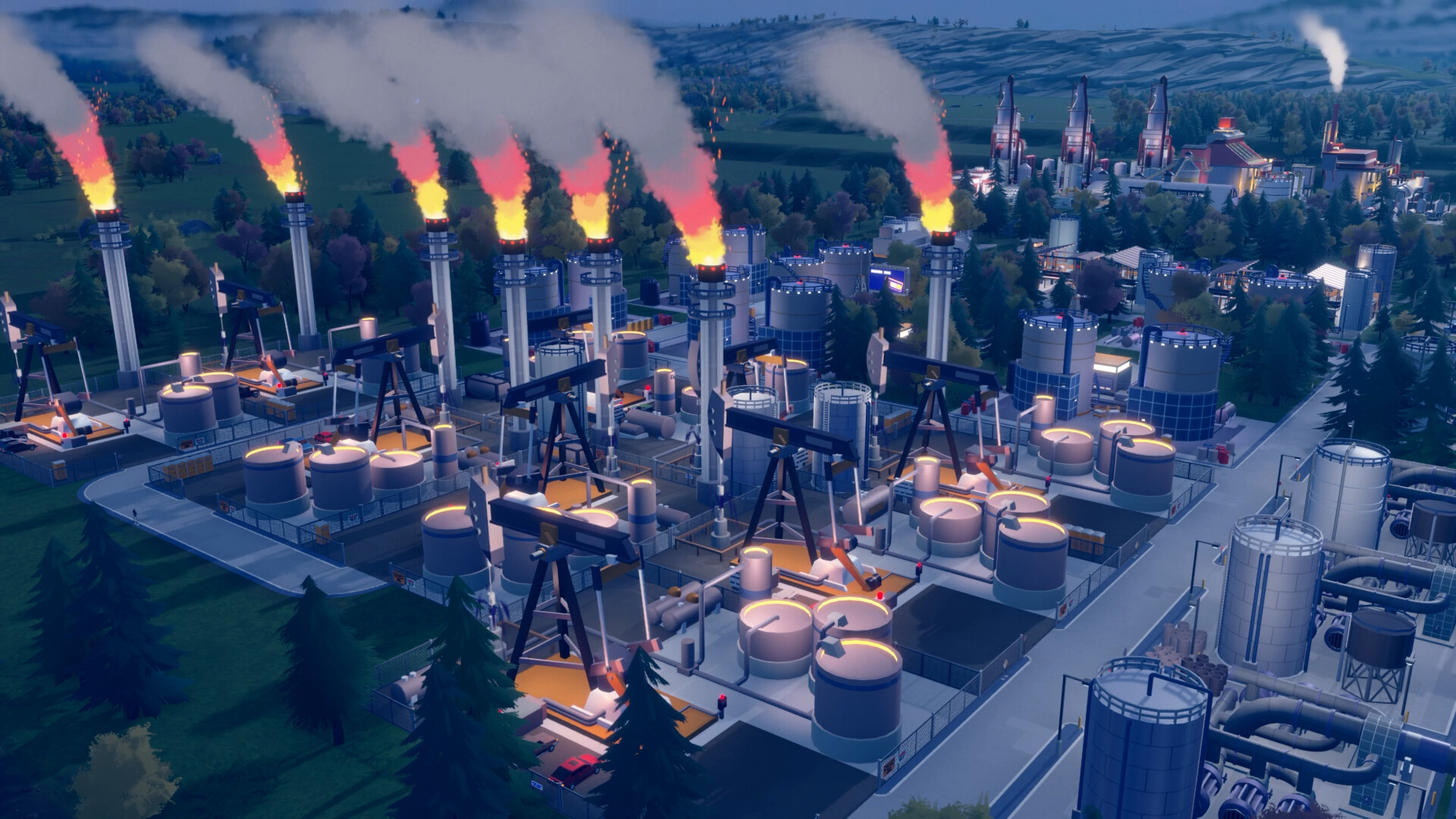
Releasing in 2019, the original Rise of Industry delivered a solid, complex management simulation experience that tasked you with building your corporate empire in the 1930s, and developer SomaSim is now at work on a sequel. With a new 1980s setting, a new accompanying aesthetic, and a number of additions and changes meant to create an even more complex experience, Rise of Industry 2 is looking like a promising sequel building on its predecessor in intriguing ways. Recently, we got the chance to ask the folks behind the game about some of those key improvements, the game’s development, and more. Below, you can read our interview with SomaSim co0founder Matt Viglione.
"Creating an empire of factories, farms and distribution networks, spinning up the industrial clockwork and ensuring that it keeps ticking as you expand – all of that was a lot of fun in the original and it is still the bedrock of the sequel."
What were the biggest lessons you took from the first game as you started development on Rise of Industry 2?
This may be obvious considering that we decided to make a sequel, but the core tycoon/management core of the remains extremely compelling. Creating an empire of factories, farms and distribution networks, spinning up the industrial clockwork and ensuring that it keeps ticking as you expand – all of that was a lot of fun in the original and it is still the bedrock of the sequel.
When it comes to changes, I think we can talk about one big change that pulls in a bunch of others. In the first game, production and extraction facilities were sort of single instrument tools: you built a coal mine to dig up coal, a farm to grow wheat, a mill to create cloth, etc. In RoI2, the basis of production and extraction shifts from these “unitaskers” into more multi-purpose complexes. We wanted to provide a deeper role in managing and developing factories – to make them more customizable and extensible.
So in RoI2, rather than build a steel mill, you build a metallurgy complex that contains numerous elements required to support multiple kinds of smelting and refining. To be a bit more concrete – making carbon steel takes coal and iron ore. Both of those need to be stored onsite once they’re delivered by truck or train. Then you also have to store the steel once it’s rolled at the mill, so that’s a different type of storage from the big piles of iron ore and coal. Steel also gets transported differently than its ingredients, so that also means different types of loading facilities. Plus you need utilities – in this case power and water.
As you expand and customize production – say adding wire manufacturing to your metallurgy complex – you have ensure that your complex can support the expansion. Do you have the right kind of storage for both raw materials and finished products? Enough loading docks? Can your power transformers in the complex handle the increased demand? And can you afford the costs and ongoing expenses with such an expansion given all of that?
If you need more steel means more iron ore, that might mean upgrading several things in your iron mine AND a few items in the steel mill to keep things in balance to accommodate that production expansion. So each complex becomes a its own small ecosystem to manage and integrate into your larger industrial superstructure.
What was behind the decision to move the game’s setting from the 1930s to the 80s? What sort of changes will that bring to the aesthetic as well as the gameplay experience?
We wanted an iconic setting – so in the same way that the Art Deco style of the original immediately put you into the 30s, Postmodern architecture does the same for the 80s. And just like in the 30s, the world was rebounding from the crashes and depression of the late 20s, the US in the 80s was emerging from some fairly dark years in the 70s with oil embargos, stagflation and far too many earthtones. The 80s gave us a chance to revisit an optimistic, forward-looking time of opulence and growth that had lots of neon fluorescent color.
So, our art team spent a lot of time looking at how that postmodernism of the 80s gets reflected in the architecture – inclusive of residential, commercial and industrial buildings. We made that our touchstone for buildings. We did the same with UI – product and graphic design of the era forms the basis of the visual language we employ there. In terms of writing, we tried to strike an optimistic tone – but at the same time in the 80s, we knew that things like pollution and climate change were probably a problem, but they just weren’t in the foreground of thought like they are today. And our composer had a really good time with 80s inspired soundtrack. So hopefully that all comes through and we’ve created some solid 80s vibes!
In terms of game play, one thing that comes to mind is that we made technology a lot less linear. It’s the 1980s – it’s not so much about discovery of new tech but rather just being able to gain access to it. So if you want to make microprocessors, you simply have to be willing to accumulate enough research to get it.
Also as we’ll discuss in a bit, the world in 1982 was far more interconnected and interdependent than it was in 1932, so communication and connection beyond your immediate region are far more important to industrial success.
"Our art team spent a lot of time looking at how that postmodernism of the 80s gets reflected in the architecture – inclusive of residential, commercial and industrial buildings. We made that our touchstone for buildings."
With Rise of Industry 2’s new setting also bringing with it plenty of new businesses, how are you expanding on the first game’s mechanics to ensure that players are able to grow and expand these new businesses in a way that feels true to the general gameplay feel of the first game?
At their core, industrial processes are fairly similar – you need to have inputs arriving sufficient to create outputs and those outputs need to be sold at such a price to make a profit. That’s true if you’re making apple juice or cameras. So on the one hand, it’s a matter of securing the correct supplies and the technology to use them. And as we mentioned above, we’ve made it so that you can acquire technologies in any order and without any prerequisite.
But just because you can make cameras, you have to decide if it makes economic sense for you to do so. Do you have access to raw materials? Can you sell them in enough quantity to make a profit? If you’ve been focusing on making wine and bottles and growing grapes, why would you switch to camera production? On the other hand, if you’re already making plastic, wires and glass – perhaps cameras make sense as the next step in your economic growth. We’ll talk about contracts and global trade in a moment, but as you expand into new product lines, you’ve always got to make sure that it’s what’s makes the most sense for your company.
What sort of an impact will the imports and exports mechanic have on the overall gameplay structure?
Contracts to buy and sell goods are at the core of the game’s economy. They’re how you make money and how you gain materials that you might not have access to in a given scenario. And in order to grow your company, to expand production, you’ll need to carefully manage these contracts and the business relationships that form around them.
As an example, let’s look at how you can leverage an existing business relationship to gain a new opportunity. We’ll imagine a situation where you’re making regular steel but you want start making stainless steel. That means you also need chrome ore. But you don’t know anyone who sells chrome. Here’s where your business connections and a carefully cultivated relationship come in handy. A quick glance through your address book reveals that the company that you’ve been buying coal from for a while does know a chrome supplier.
Looking into your relationship with them, you can see that you’ve been a good customer who pays bills on time. You’ve maybe gone to lunch a few times or even played golf together. And you’ve been understanding when they’ve had a couple of delivery glitches. Given that history, they’re willing to help out by introducing to a chrome supplier.
With chrome thus secured, you’ll also need more iron ore. In this case, you’re selling some of your iron ore from your mines that was in excess of your need. Could that be better used to make more stainless steel if you cancel the contract? Or should you just expand your mines to keep the agreement while also expanding production? On the one hand, it could be cheaper to cancel the contract, but if it’s a valuable relationship or you need the revenue, perhaps it’s best to expand the mine. As CEO, those are just some of the big decisions that are going to land on your desk.
"Between balancing complexity with fiction expectations, ensuring information clarity and relying on a scenario progression, our hope is that this resonates with both new players to the genre and longtime players – like me."
By definition management sims can be a tricky genre for newcomers to get into, but at the same time, it’s also a genre where existing fans can be very sensitive to anything that can be perceived as being too streamlined or simplified. How do you strike a balance between the two to ensure that your game is welcoming to both newcomers and returning fans?
Agree completely that it’s a big challenge that I think emerges from two places – one is creating the correct amount of complexity in the first place and the second is presenting information about that complexity in the right places at the right times. And I think if you get both of those correctly in phase, that goes a long way toward achieving that goal of approachability while maintaining the complexity expected by genre players.
Briefly, I think of the difference between Crusader Kings 2 and 3. CK3 is a more complex than game 2 – but not massively so. But CK3 is exponentially more approachable than its older sibling precisely because it rebalances the complexity and does a fantastic job of presenting the right info at the right moment.
So that’s our target – firstly we want to make sure that when we’re adding complexity that it serves the fiction. Does it make sense for the CEO to be managing individual trucks? Not really. A CEO would just tell someone “Get the right amount of coal from the mines to the mills” and leave the details of execution to an underling. So while in RoI2 you have to manage delivery routes and make sure that they’re balanced, the details of truck management can be elided into a daily cost. But when you need to spend big capital to expand a complex to accommodate more trucks, those are the kinds of decisions that would hit your desk with a bunch of implicit subsequent questions like where to build it, if you can afford it, how to integrate it into an existing complex, etc.
At the same time, you’re running what will become a pretty complicated industrial empire. You’ll want quick answers to things like “How much steel are we making each day?” “Is that enough for our contracts or do we have too much/too little?” As CEO you would expect to have those answers at your fingertips at all times. So each time we’re asking a player to make a choice – be that explicitly or implicitly – we always ask ourselves if there’s the right amount of easily available, contextual information present.
Additionally, campaign mode gives us some options when it comes to slowly introducing systems to the player. We don’t need to show them how to mine coal, make coke, make steel, farm fruit, make juice, create packaging or make cars all at once. While you can do essentially whatever you’d like in each scenario during a campaign, they are guided by investor goals and easily available resources and techs. So we can focus one scenario on metals, another on alcohol manufacture, another on microchips, things like that.
To be clear, we’re not talking about any kind of “easing in” to complexity during a campaign – the first scenario will be just as “complex” as the last, but it does allow us start players in different situations. As an example, in one scenario a player may be able to buy all the power that they need from a regional grid, but in another, that may not be anything like sufficient, so they need to build out their own generation facility. Or in a scenario, there may be no one who sells the player sand, so to make silicon for chips, they have to go build mines and engage in deep vertical integration from the start.
So between balancing complexity with fiction expectations, ensuring information clarity and relying on a scenario progression, our hope is that this resonates with both new players to the genre and longtime players – like me.
Roughly how long will an average playthrough of the campaign be?
A campaign will be 15 scenarios and each scenario is probably 4-6 hours (give or take), so 60-90 hours for one campaign run? Each scenario has multiple goals and numerous paths to succeed in it, so we’re hoping that this sets players up for multiple campaign runs!
Do you have any plans to also bring the game to the Switch?
There are no plans at the minute – primarily for optimization for a smaller screen and processing capabilities.

















